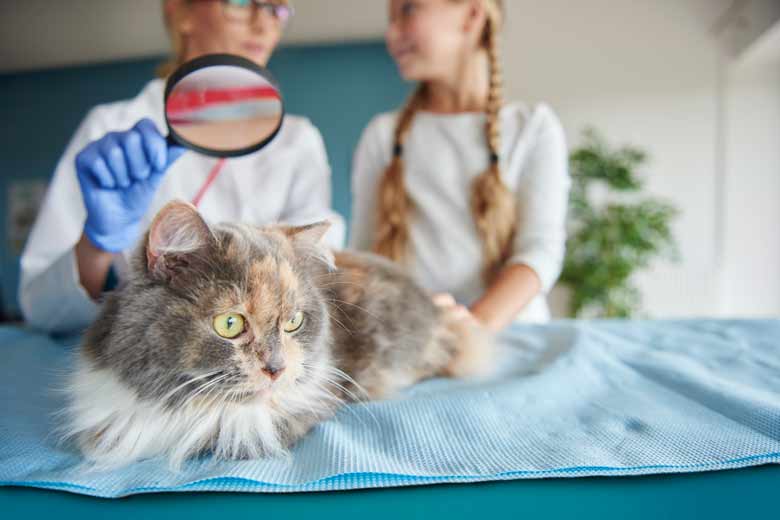
Is a disease that results in inflammation of the bladder (cystitis) and/or the urethra (urethritis). The condition may result in partial or complete obstruction of the urinary tract preventing your cat from being able to pass urine and empty their bladder. Urinary obstructions are life threatening and require immediate treatment. Without intervention bladder rupture and acute kidney failure can result.
Cause
The exact cause of FLUTD is unknown – there may be more than one single cause. It is a complex condition where a number of factors contribute to the development of the disease, including age, sex, obesity, diet and urine pH. Stress itself may be partially to blame. The presence of bladder sediment/crystals can cause inflammation of the bladder and can also form ‘plugs’ which can mechanically block the flow of urine.
A percentage of cystitis cases are due to a sterile process causing inflammation, there may or may not be a bacterial infection associated with the disease. Inflammation of the urinary tract alone can cause irritation resulting in persistent spasm of the smooth muscle that allows urine to pass, preventing the bladder from emptying.
CLINICAL SIGNS
Most clinical signs result from urinary tract irritation/inflammation, blockage or partial blockage. Your cat may be doing one or more of the following things:
- spending prolonged periods squatting and straining during urination
- may only pass very small amounts of urine, or be completely non productive
- will attempt to urinate more frequently
- may cry while attempting to urinate
- has blood-tinged urine (pink or red urine)
- urinates in unusual places, for example, the bathroom sink or bath.
Sometimes it is difficult for owners to tell whether the cat is trying to urinate or is constipated.
If the urinary tract is completely obstructed (blocked), your cat may:
- show any of the above signs
- be lethargic, vomit and have no appetite
- have pain when the abdomen is touched
- have a swollen lower abdomen.
- be so ill they are unable to walklood-tinged urine (pink or red urine)
TREATMENT
When FLUTD is suspected, tests are required to confirm the diagnosis. This usually requires analysis of the urine. In some cases, x-rays and blood tests may be required to assess if your cat is in a critical or life-threatening situation. If the bladder is blocked, a general anaesthetic is required to relieve the obstruction, flush out the urethra and place a tube (catheter) into the bladder to allow drainage. Intravenous fluids are usually required. This is usually followed by a period of hospitalisation in intensive care for several days.
When your pet returns home, it should be confined indoors for 3-4 days. Re-blockage can occur after catheter removal, so we need to ensure that your cat is able to pass urine daily by using a litter tray. Your pet will be sent home with oral medications to be continued and completed. These medications may be antibiotics, antispasmodics and/or pain relief. These medications are to complete treatment of your pet’s condition and to try and prevent immediate recurrence.
MANAGEMENT
At home, to manage and minimise long term recurrence of the condition your pet’s diet will be altered. Only diets prescribed by your veterinarian are suitable to dissolve crystals, if they are a part of the condition, and maintain bladder health. There are NO products available from supermarkets or pet shops that can do this.
If placed on a crystal dissolving diet, your pet should eat the diet for ONLY 6 weeks at which point the urine is again checked for crystals, bacteria etc. If it is normal, then the diet will be altered to a urinary maintenance diet. The prescription diet will not work if any other food is eaten.
There are other components of your cat’s health that may need to be addressed and managed.
- Weight Loss: If your pet is overweight then it is important that weight loss is achieved.
- Stress Management: Stress levels also need to be managed – this can be done by identifying and removal of stressors and improving environmental enrichment e.g. more toys, interact/play/spend time with your cat, use of boxes, cat stands (high safe places) etc… Use of Feliway, a synthetic feline pheromone, is also highly recommended for the management of stress related FLUTD. If stress and anxiety are severe, medication prescribed by your veterinarian may be required.
- Increase Water Intake: this is beneficial to bladder health – water fountains can be a fun way for your pet to drink more. Wet food versions of your cat’s prescription diet can also be fed to improve moisture intake – discuss this with your vet to ensure your cat doesn’t consume too many calories.
- Litter Trays: rule-of-thumb providing one litter tray per cat plus one. Not making unnecessary changes to litter substrate – cats can be sensitive to these changes!